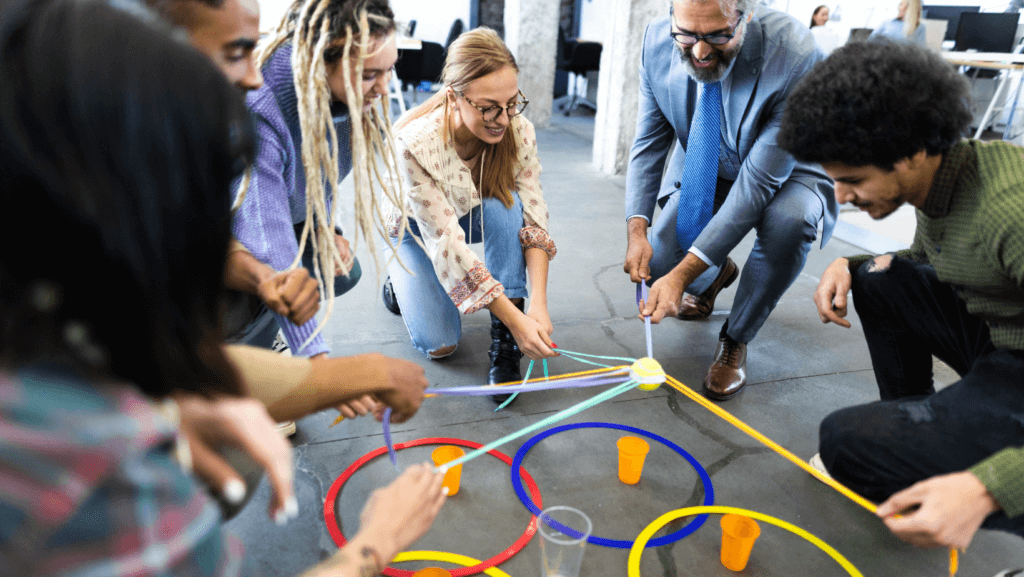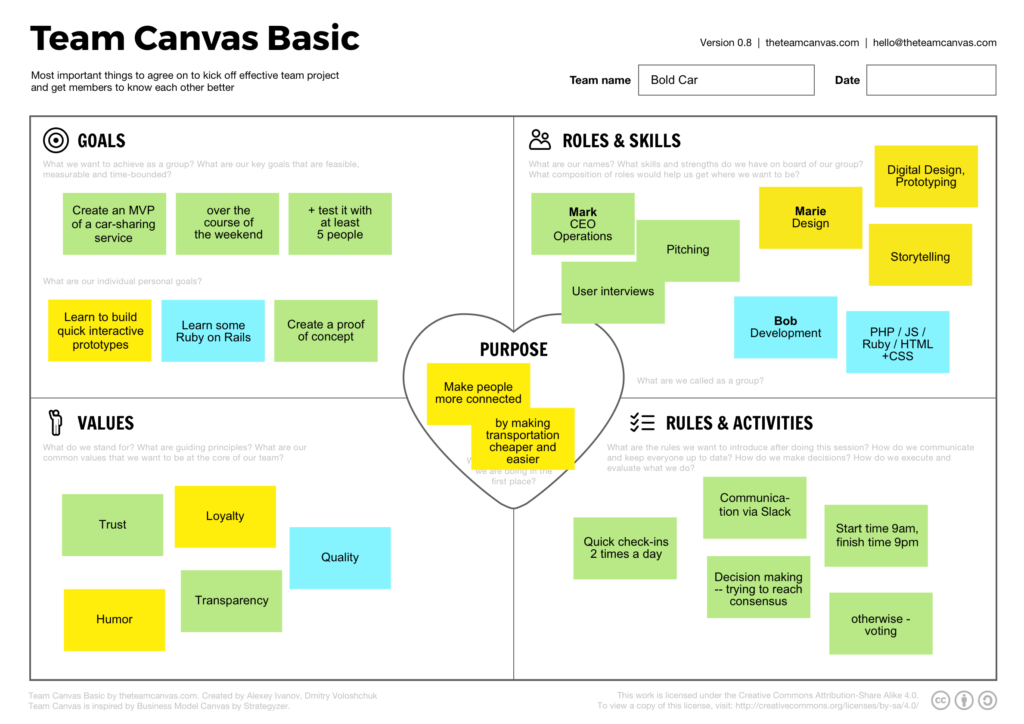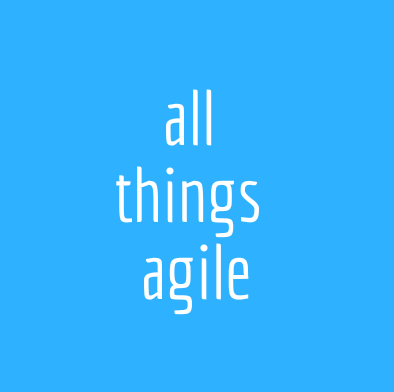
In a previous blog, we discussed how ineffective team building activities can be. Many focus on fun and excitement but are not at all related to work. So today, we are going to propose something better and discuss how to build teams effectively, as well as the role of fun and games (if any) in team building activities.
If you’d rather watch a video than read, check out my Youtube video on this topic:
Table of Contents
ToggleTeam building is not socializing
To put it simply, the purpose of team building is to build a team, not to socialize. This can be a bit confusing since teams are social systems, but socializing the way we do in our personal lives is different and is not necessary for teams.
In a study by Hackman and Wageman on team coaching, they define teams as “real groups…intact social systems, complete with boundaries, interdependence among members, and differentiated member roles”. They also “have one or more tasks to perform” and “operate in a social system context”.
This study also points out that team performance is defined by the stakeholders, not how much the team enjoys working together. The stakeholders will only perceive you as a valuable, performing team if you are productive and delivering results. They don’t use the interpersonal relationship piece. This is a good thing when we consider that teams are becoming larger and more spread out across the world. It can be difficult to think about what socializing and being “friends” could look like in that context.
Once you remove the interpersonal relationship piece, team performance, effectiveness, and competence becomes much easier to define and pursue. Team effectiveness is a function of the level of effort and how they work together, the processes they build and the appropriateness of the tasks, and the level of skill that they bring. So as long as you are focusing on these elements, you’re likely to have a team that will be high performing.
So, How do we build teams?
Build around the goal
The first element to structure your team building around is the goal, or the mission the team is trying to achieve. You can imagine activities that focus on understanding the goal looking like whiteboards and project managers/stakeholders coming to talk to the team about the problem and customer. You could have workshops about how the customer faces certain problems or uses certain tools. Anything that helps the team really understand how they come together to achieve that goal and their role in satisfying the customer.
Remember though that this is beyond just telling the team what their purpose is. The team needs to buy in, own, and understand inside out what the goal looks like. This understanding of what brings them together helps build a solid foundation for teams as they face challenges.
Build around necessary tasks and skills
You can also build the team around the necessary tasks and skills that are helpful to achieving their goal. Every team will require a unique set of skills depending on what they are delivering. For example, the skills required in a marketing team vs. an app development team. Sometimes you may have some interconnectedness between teams, but don’t lose sight of the unique tasks and skills for achieving a specific goal.
Any type of training or workshop where those skills are utilized and amplified is building the team. It’s not enough just to have members gain those skills individually though, they need to go through this workshop together, as a team. For example, it’s different to code by yourself than to code with a group of people that shares responsibility for the final deliverable product.
Build around a topic of interest
The team will need more than just practical skills to get it to a high level of performance. Things like team dynamics and communication also play a role. Lectures or workshops that define and ask members what these things mean to them as a team can be very beneficial. Teams can consume content and discuss it, or creatively come up with their own ideas, to start forming what good communication looks like for their team. They should also think about what a great team dynamic looks like, how to maintain quality, and how to spot if it’s slipping.These are aspects that are a little bit less acknowledged, but are still important for the team to understand how they want to create effective processes for how they want to work, perform those skills, and achieve their goal.
Build around team effectiveness models
Team effectiveness models help the team determine what they define as a great team, what are the ingredients, and how to achieve them. (Check out my blog on team models!) An activity based on a team model might be to have the team generate a team charter, or working agreement, that will outline the norms of conduct. The team would decide how they want to work together and the things that are so fundamental to their processes that they should be written down to become guideposts.
This is the kind of activity that teams are typically more used to. They are great to do as a team is starting, but should be revisited throughout the life cycle of the team, especially when you have some down time or after a major delivery, whether it was a big success or a big learning moment. Team effectiveness models can provide great exercises to build the team.

Can you use games to build teams?
Definitely, yes! The caveat is that you need to pay attention to how much fun. Sometimes the team can get lost in the fun and you, or the facilitator, is not allocating enough time to discuss what we are learning and what the point of it all is. It can all amount to too much fun and not enough growth.
One example of a gamified activity is Lego Serious Play where Legos are used to solve collective problems. Using the Legos allows teams to talk through problems using almost a new kind of language. It creates a few layers of abstraction that allow you to get a bit more distant from the problem itself and a bit more creative. The distance that these games provide allows you to talk about things that can be a bit more difficult to talk about if you had to be more direct.
But, as a facilitator, you need to be experienced with the technology you’re using, as well as with asking the right questions to make sure you can help the team extract the learning after the fun.
Gamified approaches to solving complex problems help you simplify the language you’re using and tend to be quite effective. You can also use them at any given point in time, which is another plus. But remember, fun is not the objective, learning is. Also, differences among people, culturally, neurotypically, etc. will play a part here and are important to consider.
In my own experience, I’ve created and facilitated activities using playdough and Post-its. The goal was for the team to build a house and they only had a set number of weeks to do it. They had to plan and determine the cycle of deliverables. Eventually though, they ran out of materials because they used them all upfront, even though they had already committed to a lot of elements that were yet to be built. This offered a space to debrief in the context of the house building and then bring it back to their own work in software development.
If you use these activities, get creative but also intentional. You want to create an environment for the team to take away more lessons than the ones you are trying to give to them. Create a space and pay attention to all the things they do. Ask questions so they can notice patterns and issues arising. You are not trying to force a message on them, you are providing a space for them to design their own effectiveness and team processes.
Again, the goal is to help your team become more effective and high performing, and achieve the results they were tasked to achieve.
If you are interested in learning about how to coach for team development and success, check out my Agile Coaching Program! It’s a month-long course of learning by doing! We have recently amped up the conflict navigation, team development, and agile principles in practice areas of the course so it is truly better than ever. In addition, we are proud partners with ICAgile so you will receive a highly recognized certification upon completion that will set you up well for a career as an agile coach.



